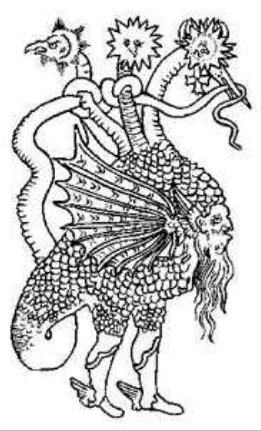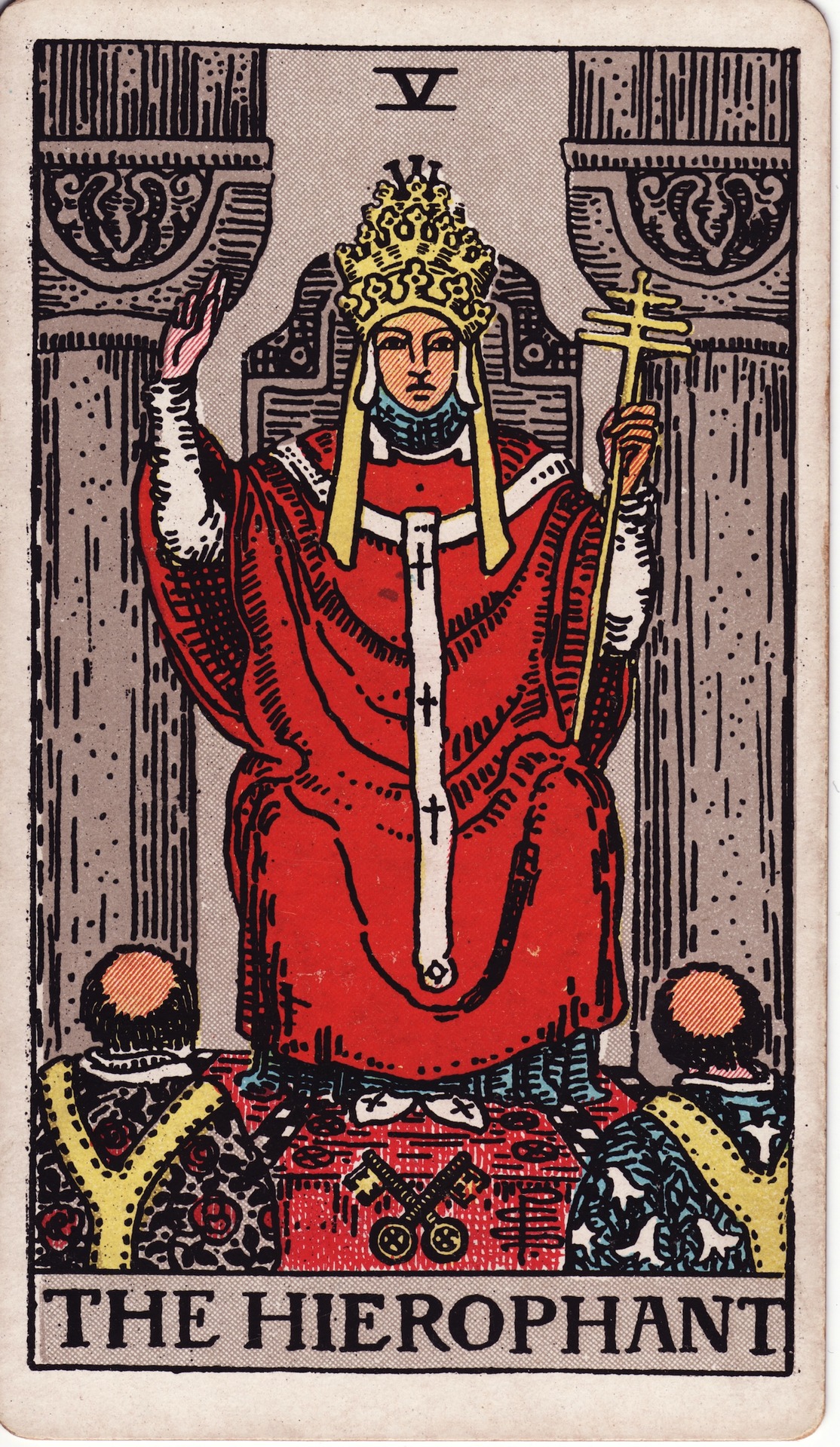|
Hierophant
A hierophant ( grc, ἱεροφάντης) is a person who brings religious congregants into the presence of that which is deemed ''holy''. As such, a hierophant is an interpreter of sacred mysteries and arcane principles. The word comes from ancient Greece, where it was constructed from the combination of ''ta hiera'' ('the holy') and ''phainein'' ('to show'). Greek priesthood In Attica, ''Hierophant'' was the title of the chief priest at the Eleusinian Mysteries. It was an office inherited within the Philaidae or Eumolpidae families. The office of Hierophant, High Priestess and Dadouchousa Priestess were all inherited within the Philaidae or Eumolpidae families, and the Hierophant and the High Priestess were of equal rank.Pomeroy, Sarah B, Goddesses, whores, wives, and slaves: women in classical antiquity, Schocken Books, New York, 1995 It was the task of the High Priestess to impersonate the roles of the goddesses Demeter and Persephone in the enactment during the Mysteries. ... [...More Info...] [...Related Items...] OR: [Wikipedia] [Google] [Baidu] |
Eleusinian Mysteries
The Eleusinian Mysteries ( el, Ἐλευσίνια Μυστήρια, Eleusínia Mystḗria) were initiations held every year for the cult of Demeter and Persephone based at the Panhellenic Sanctuary of Elefsina in ancient Greece. They are the "most famous of the secret religious rites of ancient Greece". Their basis was an old agrarian cult, and there is some evidence that they were derived from the religious practices of the Mycenean period.Dietrich (1975) ''The origins of Greek Religion''. Bristol Phoenix Press pp. 166, 167 Walter Burkert. (1985)''Greek Religion''. Harvard University Press. p. 285 The Mysteries represented the myth of the abduction of Persephone from her mother Demeter by the king of the underworld Hades, in a cycle with three phases: the ''descent'' (loss), the ''search'', and the ''ascent'', with the main theme being the ''ascent'' () of Persephone and the reunion with her mother. It was a major festival during the Hellenic era, and later spread to Rome. ... [...More Info...] [...Related Items...] OR: [Wikipedia] [Google] [Baidu] |
Vettius Agorius Praetextatus
Vettius Agorius Praetextatus (ca. 315 – 384) was a wealthy pagan aristocrat in the 4th-century Roman Empire, and a high priest in the cults of numerous gods. He served as the praetorian prefect at the court of Emperor Valentinian II in 384 until his death that same year. Sources His life is primarily known through the works of Quintus Aurelius Symmachus and Ammianus Marcellinus, supplemented by some epigraphical records. Symmachus (345 c. – 402 c.) was a leading member of the senatorial aristocracy of his time and the best orator of his age. Symmachus' letters, speeches and relations have been preserved and testify a sincere friendship between Symmachus and Praetextatus: according to Symmachus, Praetextatus was a good magistrate and a virtuous man.Kahlos (2002), Introduction. Ammianus Marcellinus, writing in the early 390s, tells about Praetextatus in three passages of his ''Res Gestae'': in all of them Ammianus shows appreciation of Praetextatus' actions, while the same aut ... [...More Info...] [...Related Items...] OR: [Wikipedia] [Google] [Baidu] |
Hierophylakes
Hierophylakes, also known as hierodidaskaloi, hieronomoi, or hierophantai, were priests for the Eumolpidae involved in performing acts of sacrifice. Pausanias stated that new hierophantai were elected every quadrennial, and so individuals did not maintain an existence within this role for their life-time. He also stated that they might marry if they wished to do so known as, lambanein gynaika. They are also mentioned in the ''HGK 1'' inscription, an important component of the state calendar created in Kos about 360 B.C. which lists the officials present at sacrifices. The Hierophylakes alongside an archeuontes are noted to make a preliminary announcement before the sacrifice of an oxen. The Hierophylakes as a role is also mentioned during the early Roman Empire in a votive inscription to Tiberius and Livia Livia Drusilla (30 January 59 BC – 28 September AD 29) was a Roman empress from 27 BC to AD 14 as the wife of Roman emperor, Emperor Augustus Caesar. She was know ... [...More Info...] [...Related Items...] OR: [Wikipedia] [Google] [Baidu] |
Eumolpidae
The Eumolpidae ( grc, Εὐμολπίδαι, ''Eumolpidai'') were a family of priests at Eleusis who maintained the Eleusinian Mysteries during the Hellenic era. As hierophants, they popularized the cult and allowed many more to be initiated into the secrets of Demeter and Persephone. The legendary genealogy of the Eumolpidae cast them as descendants of Eumolpus, one of the first priests of Demeter at Eleusis, through his second son, Herald-Keryx. Eumolpus, "untainted by blame" is named among the archaic leaders of Eleusis in the ''Homeric Hymn to Demeter'' 149–156. Through Eumolpus, they were supposedly related to either Poseidon or Hermes. The last legitimate hierophant at Eleusis, just before the extinguishing of the mysteries at the time of Alaric's invasion in 396 CE, traced his descent from Eumolpos.Eunapios' biography of Maximos the Neoplatonist is the source, quoted at length by Carl Kerenyi, ''Eleusis: Archetypal Image of Mother and Daughter'' 1967:17. The other f ... [...More Info...] [...Related Items...] OR: [Wikipedia] [Google] [Baidu] |
Eunapius
Eunapius ( el, Εὐνάπιος; fl. 4th–5th century AD) was a Greek sophist and historian of the 4th century AD. His principal surviving work is the ''Lives of Philosophers and Sophists'' ( grc-gre, Βίοι Φιλοσόφων καὶ Σοφιστῶν; la, Vitae sophistarum), a collection of the biographies of 23 philosophers and sophists. Life He was born at Sardis, AD 347. In his native city he studied under his relative, the sophist Chrysanthius, and while still a youth went to Athens, where he became a favourite pupil of Prohaeresius the rhetorician. He possessed considerable knowledge of medicine. In his later years he seems to have lived at Athens, teaching rhetoric. He was initiated into the Eleusinian Mysteries by the last Hierophant, Nestorius.Eunapius, ''Vit. Soph.'' 7.3.1; K. Clinton, ''Sacred Officials of the Eleusinian Mysteries'' (1974) p. 42ff. There is evidence that he was still living in the reign of the younger Theodosius. Writing Eunapius was the a ... [...More Info...] [...Related Items...] OR: [Wikipedia] [Google] [Baidu] |
Sacred Mysteries
Sacred mysteries are the areas of supernatural phenomena associated with a divinity or a religious belief and praxis. Sacred mysteries may be either: # Religious beliefs, rituals or practices which are kept secret from the uninitiated. # Beliefs of the religion which are public knowledge but cannot be easily explained by normal rational or scientific means. Although the term "mystery" is not often used in anthropology, access by initiation or rite of passage to otherwise secret beliefs is an extremely common feature of indigenous religions all over the world. A mystagogue or hierophant is a holder and teacher of secret knowledge in the former sense above, while mysticism may be defined as an area of philosophical or religious thought focusing on mysteries in the latter sense. Greece and Rome The mystery religions of antiquity were religious cults which required initiation of an "initiate" or new member before they were accepted, and sometimes had different levels of initia ... [...More Info...] [...Related Items...] OR: [Wikipedia] [Google] [Baidu] |
Mystagogue
A mystagogue (from el, μυσταγωγός, mystagogos, "person who initiates into mysteries") is a person who initiates others into mystic beliefs, and an educator or person who has knowledge of the sacred mysteries of a belief system. Another word for mystagogue is hierophant. Origins In ancient mystery religions, a mystagogue would be responsible for leading an initiate into the secret teachings and rituals of a cultus. The initiate would often be blindfolded, and the mystagogue would literally "guide" him into the sacred space. In the early Christian church, this same concept was used to describe role of the bishop, who was responsible for seeing to it that the catechumens were properly prepared for baptism. Mystagogical homilies, or homilies that dealt with the Church's sacraments, were given to those in the last stages of preparation for full Church membership. Sometimes these mystagogical instructions were not given until after the catechumen had been baptized. The most f ... [...More Info...] [...Related Items...] OR: [Wikipedia] [Google] [Baidu] |
The Hierophant
The Hierophant (V) is the fifth card of the Major Arcana in occult Tarot decks. It is derived from the historical card known as the Pope in playing card decks. It is used in divination. Description and symbolism In many modern packs, the Hierophant is represented with his right hand raised in blessing or benediction, with two fingers pointing skyward and two pointing down, thus forming a bridge between Heaven and Hell reminiscent of that formed by the body of The Hanged Man. The Hierophant is thus a true "pontiff", in that he is the builder of the bridge between deity and humanity. In his left hand he held a triple cross. The Hierophant is typically male, even in decks that take a feminist view of the Tarot, such as the Motherpeace Tarot, The Hierophant was also known as "The Teacher of Wisdom". In most iconographic depictions, the Hierophant is seen seated on a throne between two pillars symbolizing Law and Freedom or obedience and disobedience, according to different ... [...More Info...] [...Related Items...] OR: [Wikipedia] [Google] [Baidu] |
Hierophany
A hierophany is a manifestation of the sacred. The word is a formation of the Greek adjective ''hieros'' ( gr, ἱερός, 'sacred, holy') and the verb ''phainein'' (φαίνειν, 'to reveal, to bring to light'). Mircea Eliade The word ''hierophany'' recurs frequently in the works of religious historian Mircea Eliade, who preferred the term to the more constrictive word '' theophany'', an appearance of a god. Eliade argues that religion is based on a sharp distinction between the sacred and the profane. According to Eliade, for traditional man, myths describe "breakthroughs of the sacred (or the 'supernatural') into the World"—that is, hierophanies. In the hierophanies recorded in myth, the sacred appears in the form of ideal models (the actions and commandments of gods, heroes, etc.). By manifesting itself as an ideal model, the sacred gives the world value, direction, and purpose: "The manifestation of the sacred, ontologically founds the world." According to this vie ... [...More Info...] [...Related Items...] OR: [Wikipedia] [Google] [Baidu] |
Holy
Sacred describes something that is dedicated or set apart for the service or worship of a deity; is considered worthy of spiritual respect or devotion; or inspires awe or reverence among believers. The property is often ascribed to objects (a " sacred artifact" that is venerated and blessed), or places (" sacred ground"). French sociologist Émile Durkheim considered the dichotomy between the sacred and the profane to be the central characteristic of religion: "religion is a unified system of beliefs and practices relative to ''sacred things'', that is to say, things set apart and forbidden." Durkheim, Émile. 1915. ''The Elementary Forms of the Religious Life''. London: George Allen & Unwin. . In Durkheim's theory, the sacred represents the interests of the group, especially unity, which are embodied in sacred group symbols, or using team work to help get out of trouble. The profane, on the other hand, involve mundane individual concerns. Etymology The word ''sacred'' de ... [...More Info...] [...Related Items...] OR: [Wikipedia] [Google] [Baidu] |
Patriarchate
Patriarchate ( grc, πατριαρχεῖον, ''patriarcheîon'') is an ecclesiological term in Christianity, designating the office and jurisdiction of an ecclesiastical patriarch. According to Christian tradition three patriarchates were established by the apostles as apostolic sees in the 1st century: Rome, Antioch, and Alexandria. Constantinople was added in the 4th century and Jerusalem in the 5th century. Eventually, together, these five were recognised as the pentarchy by the Council of Ephesus in 431. In the rest of the history of Christianity, a few other patriarchates were gradually recognised by any of these above ancient episcopal sees. With time, eventually some of them fell due to military occupations following the Islamic conquests of the Middle East and North Africa, and became titular or honorary patriarchates with no actual institutional jurisdiction on the original site. History Five ancient patriarchates of the Pentarchy, headed by patriarchs as ... [...More Info...] [...Related Items...] OR: [Wikipedia] [Google] [Baidu] |




